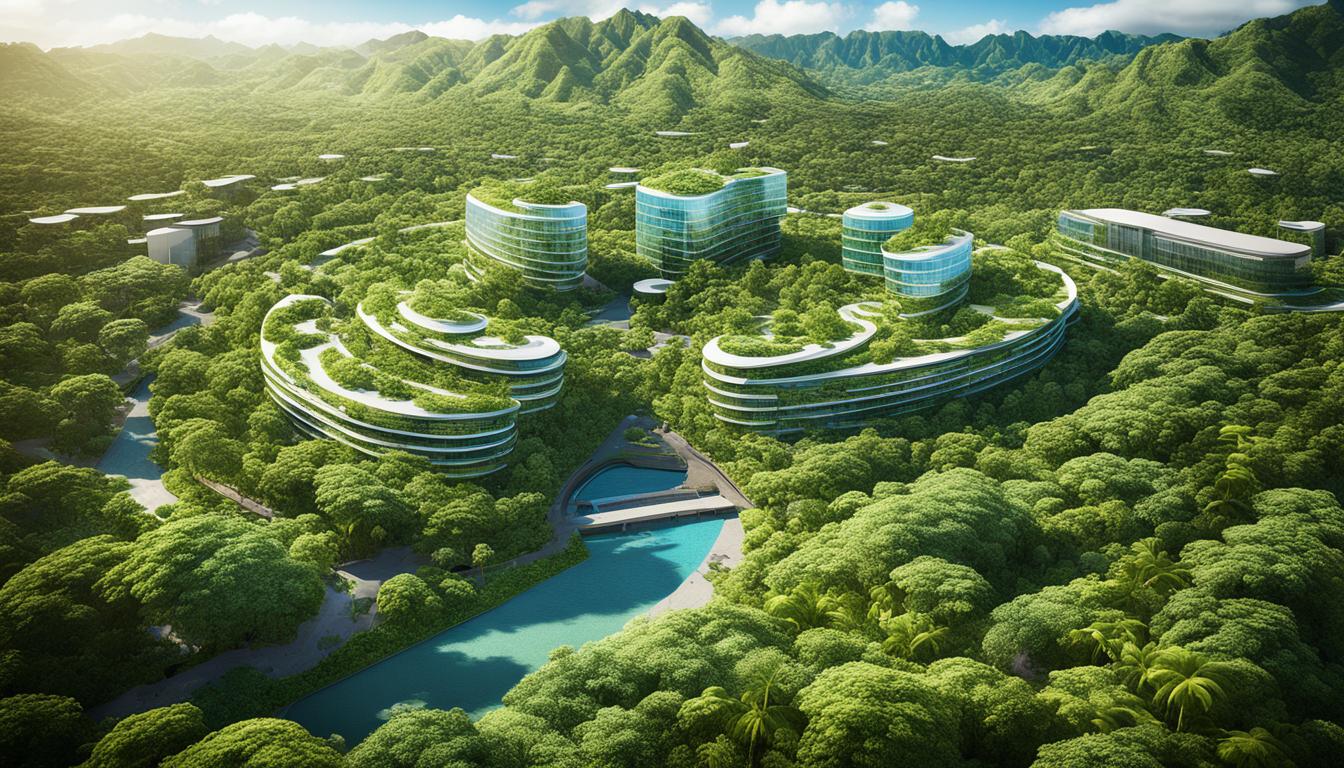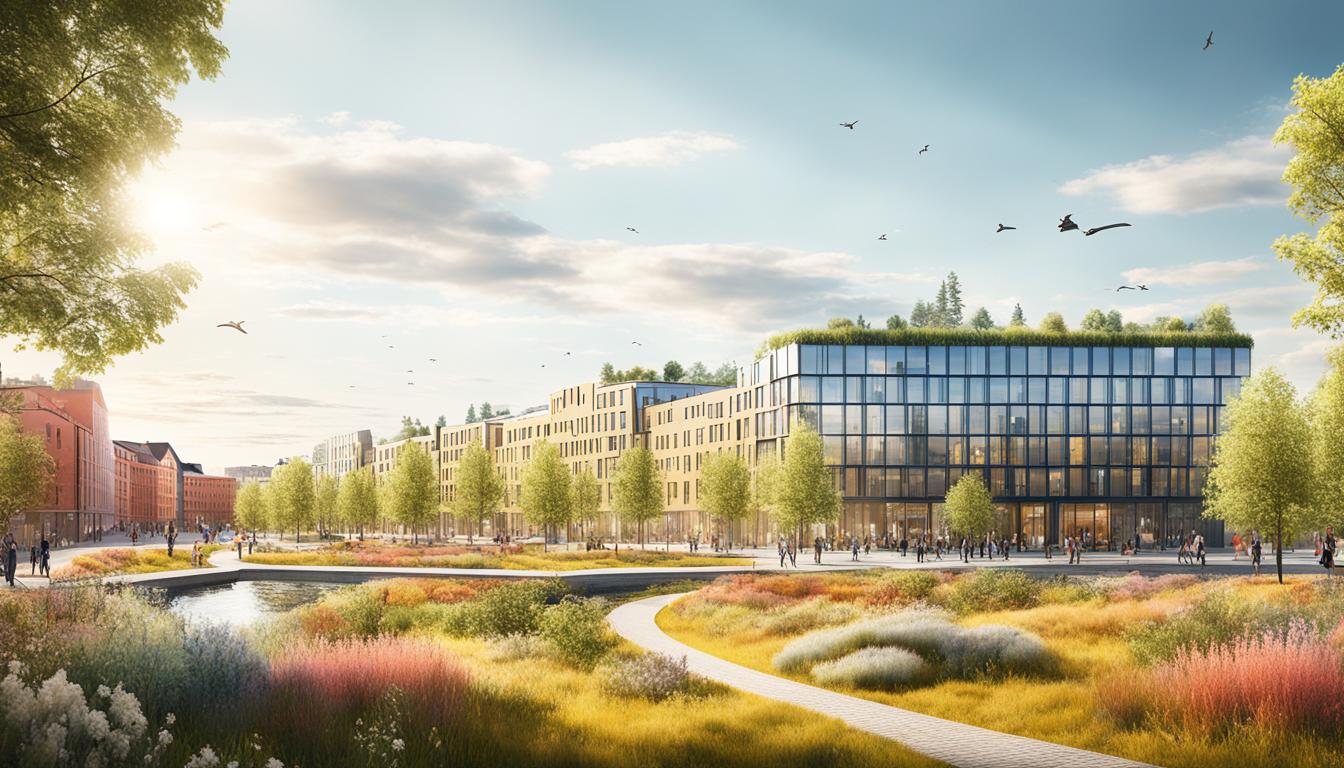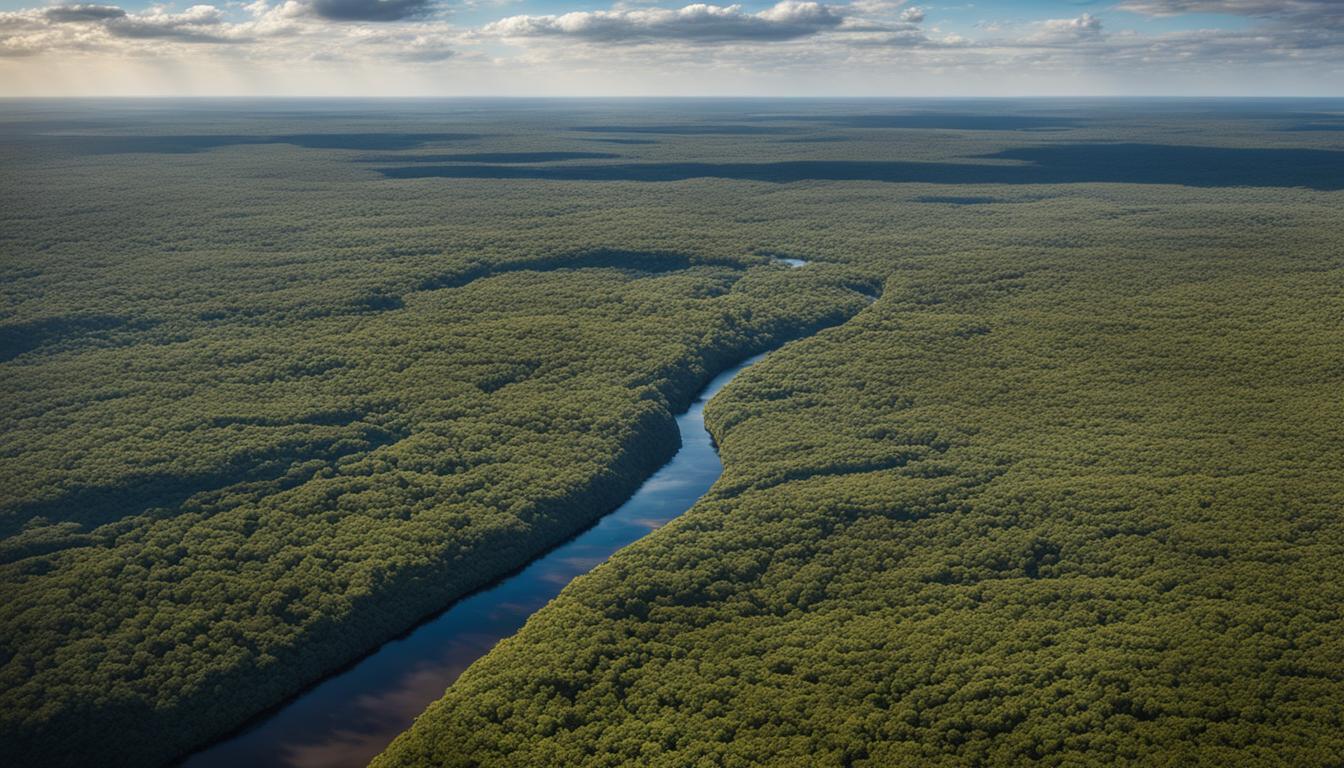Ethiopia Biodiversity and the Built Environment
Did you know that Ethiopia is home to one of the most diverse ecosystems in the world? With over 6,000 plant species, 1,000 bird species, and 285 mammal species, this African nation boasts a remarkable wealth of biodiversity. The preservation of this ecological diversity is crucial, especially in the face of urban development and environmental challenges.
As Ethiopia strives for sustainable growth, it has placed a strong emphasis on integrating biodiversity conservation into its built environment. The country has implemented various conservation efforts, promoted sustainable architecture and green building practices, and recognized the importance of balancing economic development with ecological preservation.
Key Takeaways
- Ethiopia is home to a vast array of plant and animal species, making its biodiversity highly valuable.
- The country has implemented conservation initiatives and sustainable practices to protect its natural resources.
- Efforts to balance urban development and biodiversity conservation are crucial for Ethiopia’s sustainable future.
- Sustainable architecture and green building practices play a central role in protecting biodiversity.
- Integrating biodiversity considerations into urban planning can create resilient and environmentally-friendly cities.
What is Biodiversity and Why is it Important?
Biodiversity is a fundamental aspect of our planet’s natural environment, encompassing the wide range of life forms, including genes, species, and ecosystems. It plays a pivotal role in sustaining the delicate balance of the Earth’s ecosystems, providing numerous benefits to both nature and human society. Understanding the significance of biodiversity is essential in realizing the importance of conservation and sustainability efforts in Ethiopia and worldwide.
Biodiversity holds immense value as it contributes to ecological diversity, ensuring the existence of various habitats and species. It serves as the backbone of resilient ecosystems that support life, regulate climate, and maintain critical ecological processes. Additionally, biodiversity provides essential ecosystem services, such as clean air and water, pollination, soil fertility, and disease control, which are vital for human well-being and economic development.
Conservation of biodiversity is crucial for several reasons. Firstly, it helps in preserving the intricate web of life and prevents the loss of species and genetic diversity. Each species contributes to the overall functioning of ecosystems, and the loss of even a single species can have far-reaching consequences. Secondly, biodiversity aids in mitigating climate change by sequestering carbon dioxide and regulating local and regional climate patterns.
In Ethiopia, biodiversity plays a particularly significant role due to the country’s diverse range of ecosystems. From the breathtaking afroalpine areas to the lush forests, woodlands, and vibrant aquatic ecosystems, the natural environment of Ethiopia holds immense ecological and cultural value. Protecting and enhancing biodiversity within the built environment is crucial for sustaining the unique ecological diversity and achieving sustainable development.
Table: Importance of Biodiversity
| Benefits of Biodiversity | Examples |
|---|---|
| Ecological Balance | Maintaining predator-prey relationships, nutrient cycling. |
| Climate Regulation | Carbon sequestration, temperature and rainfall regulation. |
| Ecosystem Services | Pollination, soil fertility, water purification. |
| Economic Resources | Timber, medicinal plants, fisheries. |
| Intrinsic Value | Preserving the diversity of life for its own sake. |
In conclusion, biodiversity is the cornerstone of a healthy and sustainable planet. It provides invaluable benefits to both nature and human society by maintaining ecological balance, regulating climate, and providing essential ecosystem services. Ethiopia’s biodiversity is of immense importance due to its unique ecosystems, highlighting the need for dedicated conservation efforts and sustainable practices to ensure a harmonious coexistence between the natural environment and the built environment.
Current Status and Threats to Biodiversity in Ethiopia
Ethiopia’s biodiversity is currently facing a range of threats that significantly impact its rich natural ecosystems. These threats include habitat loss and degradation, deforestation, pollution, and climate change. Each of these factors contributes to the decline of species populations and the degradation of the country’s diverse ecosystems.
The natural ecosystems of Ethiopia, such as afroalpine areas, montane forests, woodlands, and aquatic ecosystems, are particularly vulnerable to these threats. The loss of biodiversity not only affects the natural environment but also has socio-economic implications, impacting agriculture, industry, and medicine.
Pollution, deforestation, and climate change are among the key factors leading to the loss of Ethiopia’s precious biodiversity.
To illustrate the extent of these threats, let’s take a closer look:
| Threats | Impact |
|---|---|
| Habitat Loss and Degradation | Displacement and loss of wildlife habitats, reduced biodiversity |
| Deforestation | Decreased forest cover, loss of endemic species and important ecosystems |
| Pollution | Contamination of air, water, and soil, harming plants, and animals |
| Climate Change | Altered temperature and precipitation patterns, habitat disruption |
Addressing these threats and implementing conservation measures is vital to protect and preserve Ethiopia’s biodiversity. By doing so, we can ensure the continued existence of unique species, maintain ecological balance, and safeguard the socio-economic benefits associated with these ecosystems.

Habitat Loss and its Impact on Biodiversity
Habitat loss, which occurs primarily due to human activities such as encroachment, agriculture, and urbanization, is a major threat to biodiversity. As natural habitats are destroyed or degraded, species lose their homes and face increased competition for resources. This can lead to the decline of populations and, in extreme cases, even extinction.
Biodiversity Conservation Efforts in Ethiopia
Ethiopia is committed to conserving its rich biodiversity through various initiatives. These efforts aim to protect important habitats, species, and ecosystems for present and future generations. Conservation strategies in Ethiopia focus on biodiversity conservation, establishment of protected areas, in-situ and ex-situ conservation, and sustainable use of natural resources.
Protected Areas
Ethiopia has established a network of protected areas, including national parks and wildlife reserves, to safeguard critical habitats and species. These protected areas serve as sanctuaries for diverse plants and animals and play a crucial role in ensuring the long-term survival of threatened species.
In-Situ Conservation
In-situ conservation involves the protection of species and habitats in their natural environment. Ethiopia emphasizes the importance of in-situ conservation through measures such as habitat restoration, wildlife management, and the preservation of key ecosystems. This approach allows species to thrive in their native habitats and promotes the maintenance of healthy ecological processes.
Ex-Situ Conservation
Ex-situ conservation involves the preservation of biodiversity outside of its natural habitat. In Ethiopia, ex-situ conservation efforts include the establishment of botanical gardens, seed banks, and captive breeding programs. These initiatives ensure the survival of endangered species and the preservation of genetic diversity for future reintroduction or research purposes.
Sustainable Use of Biodiversity
Ethiopia recognizes the importance of sustainable use of biodiversity resources for both environmental and socio-economic benefits. Sustainable management practices are implemented in sectors such as forestry, agriculture, and wildlife to ensure the responsible utilization of natural resources while minimizing negative impacts.
By promoting sustainable practices and balancing conservation with development, Ethiopia aims to preserve its biodiversity and ensure the sustainable use of its natural resources. These efforts contribute to the country’s commitment to environmental stewardship and the long-term well-being of its people.
“Conservation is key to protecting Ethiopia’s unique biodiversity and ensuring the sustainable use of its natural resources.”
Table: Conservation Efforts in Ethiopia
| Conservation Initiatives | Description |
|---|---|
| Establishment of Protected Areas | Creation of national parks and wildlife reserves to safeguard habitats and species. |
| In-Situ Conservation | Protection of species and ecosystems in their natural habitats through habitat restoration and wildlife management. |
| Ex-Situ Conservation | Preservation of biodiversity outside of natural habitats, including seed banks, botanical gardens, and captive breeding programs. |
| Sustainable Use of Biodiversity | Implementation of sustainable management practices in forestry, agriculture, and wildlife sectors. |
The Role of Sustainable Architecture in Protecting Biodiversity
Sustainable architecture plays a crucial role in protecting biodiversity in Ethiopia. By implementing green building practices and incorporating ecosystem-friendly design principles, architects and construction professionals can minimize the environmental impact of buildings and urban development projects. Sustainable architecture focuses on reducing energy consumption, conserving water, using renewable materials, and creating healthy and environmentally-friendly spaces. Additionally, sustainable urban design can incorporate green spaces, such as parks and green roofs, which provide habitats for wildlife and contribute to biodiversity conservation in urban areas.
By integrating sustainable architecture into the built environment, Ethiopia can achieve a harmonious balance between urbanization and the preservation of biodiversity. Green building practices such as using energy-efficient materials, incorporating natural lighting, and implementing water conservation systems help reduce the ecological footprint of construction projects. These practices not only conserve natural resources but also improve the overall quality of life for residents by creating healthier and more sustainable living spaces.
Sustainable architecture also considers the long-term ecological impact of buildings. Incorporating design features that provide habitats for wildlife, such as birdhouses, bat boxes, and green facades, helps mitigate the loss of natural habitats caused by urbanization. By creating green corridors and connecting natural spaces, sustainable architecture promotes the movement of species and enhances biodiversity conservation efforts.
Did you know?
Sustainable architecture in Ethiopia has gained significant recognition through projects such as the Entoto Park and Addis Ababa Riverside Project. These initiatives showcase the integration of green spaces, renewable energy systems, and sustainable building practices into urban development, demonstrating Ethiopia’s commitment to protect biodiversity through sustainable design.
Furthermore, sustainable urban design goes beyond individual buildings to consider the overall layout and infrastructure of cities. By incorporating green infrastructure, such as urban forests, parks, and greenways, urban planners can create interconnected green spaces that support biodiversity and provide recreational opportunities for residents. These green spaces help cool urban areas, reduce air pollution, and provide important habitats for birds, insects, and other wildlife.
The Benefits of Sustainable Architecture for Biodiversity Conservation:
- Minimizes the ecological impact of buildings and urban development projects
- Reduces energy consumption and conserves water resources
- Enhances the health and well-being of residents
- Preserves natural habitats and provides habitats for wildlife
- Incorporates green spaces and improves urban biodiversity
To illustrate the positive impact of sustainable architecture on biodiversity, consider the following example:
| Sustainable Architecture Initiative | Benefits for Biodiversity |
|---|---|
| Installation of green roofs on buildings | – Provides foraging and nesting opportunities for birds – Improves air quality – Reduces energy consumption by insulating buildings |
| Integration of urban forests and green spaces | – Creates wildlife corridors for species movement – Enhances urban biodiversity – Provides recreational spaces for residents |
| Use of renewable materials in construction | – Reduces the ecological impact of resource extraction – Minimizes waste and carbon emissions |
By implementing sustainable architecture practices, Ethiopia can lead the way in promoting a built environment that not only meets the needs of its growing population but also safeguards the country’s unique biodiversity. Through a combination of green building practices, urban design strategies, and ecosystem-friendly construction, Ethiopia can create sustainable cities that protect and enhance biodiversity for future generations.
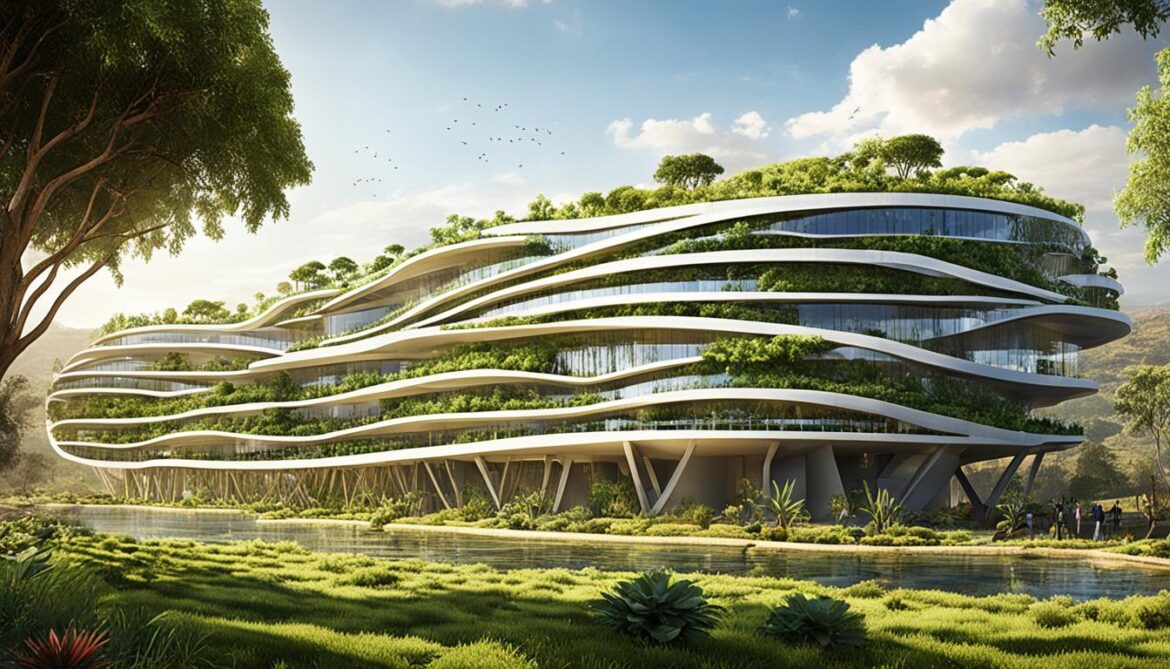
Urban Development Projects and their Environmental Impact
Urban development projects in Ethiopia have a significant impact on the environment, with both positive and negative consequences. While these projects contribute to economic growth and the improvement of infrastructure, they can also result in habitat destruction and ecosystem fragmentation. It is important to understand the environmental implications of urban development and implement sustainable practices to minimize the negative effects.
The expansion of cities and the construction of new buildings often lead to the conversion of natural habitats into urbanized areas. This conversion disrupts ecosystems and displaces wildlife, causing habitat destruction and loss of biodiversity. The fragmentation of ecosystems further exacerbates these issues, as fragmented habitats are less resilient and struggle to support diverse and thriving populations of plants and animals.
“Urban development projects can bring about positive change, but we must also consider their impact on the environment. It is crucial to find a balance between development and conservation to protect Ethiopia’s rich biodiversity.” – Environmental Expert
To mitigate the environmental impact of urban development projects, it is essential to implement environmentally sustainable practices. This includes incorporating green infrastructure, such as parks and green spaces, into urban planning to provide habitats for wildlife and promote biodiversity. Additionally, adopting sustainable construction methods and materials can minimize the ecological footprint of buildings and reduce resource consumption.
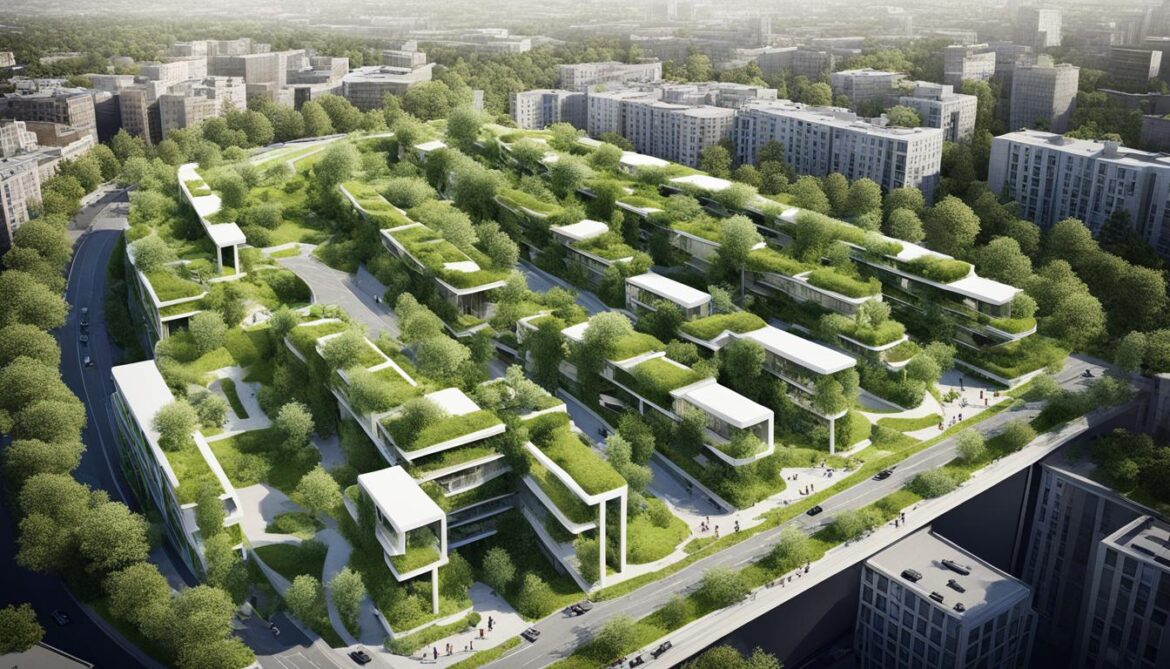
By considering the environmental impact of urban development projects, Ethiopia can work towards a more sustainable future where economic growth and conservation can coexist harmoniously.
Integrating Biodiversity Conservation in Urban Planning
Integrating biodiversity conservation in urban planning is essential for promoting sustainable development in Ethiopia. By incorporating biodiversity considerations into the planning process, Ethiopia can create more resilient and environmentally-friendly cities that support both human well-being and the conservation of biodiversity.
One effective approach is the implementation of green infrastructure, which includes the creation of parks, green spaces, and urban forests. These natural areas provide important habitats for wildlife, allowing them to thrive in otherwise urbanized environments. Green infrastructure also contributes to the preservation of biodiversity by creating interconnected ecosystems within the urban landscape.
Urban planners play a crucial role in prioritizing the protection of natural areas and the restoration of degraded ecosystems. By identifying and preserving these spaces, they can ensure the continuity of wildlife habitats and the preservation of biodiversity. Additionally, urban planners can integrate green infrastructure into urban design, allowing for the seamless integration of nature within the built environment.
“Integrating biodiversity considerations into urban planning is not only essential for the conservation of wildlife but also for the well-being of the urban population. By creating sustainable and nature-rich cities, we can enhance the quality of life for both humans and the environment.”
By incorporating biodiversity conservation in urban planning, Ethiopia can foster urban ecosystems that support a wide range of wildlife and promote the coexistence of nature and urban development. This approach ensures the long-term sustainability of cities while preserving the country’s rich biodiversity.
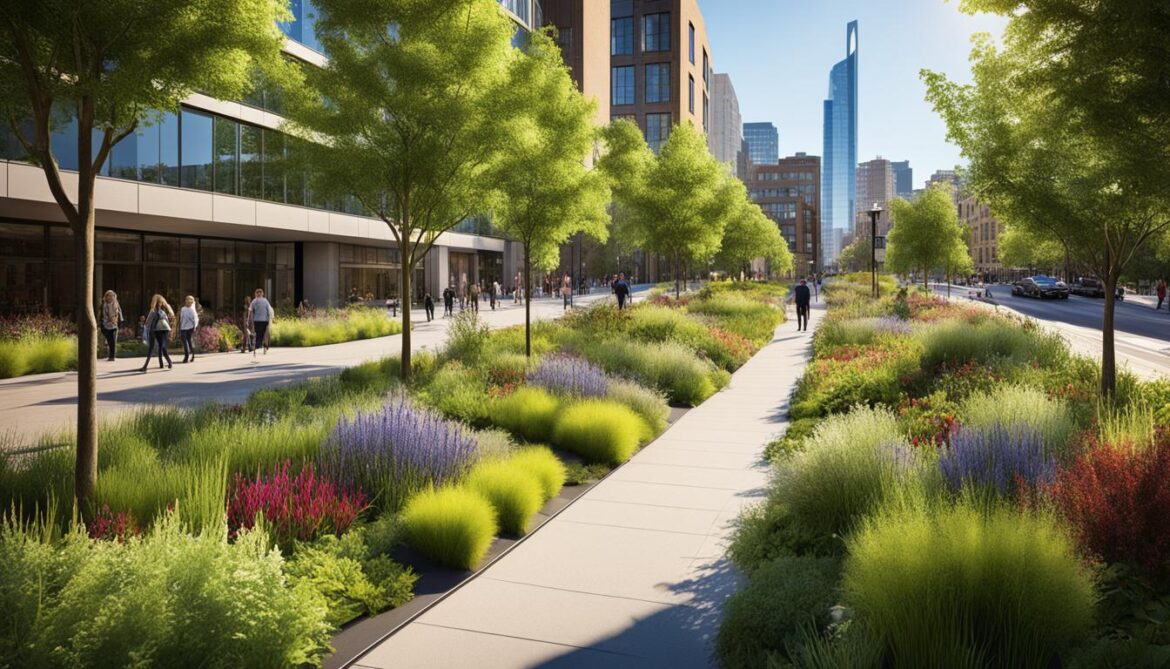
Benefits of Integrating Biodiversity Conservation in Urban Planning:
- Promotes the preservation of biodiversity within urban areas
- Creates important habitats for wildlife
- Enhances the environmental quality of cities
- Improves human well-being through access to nature
- Increases resilience to climate change impacts
Integrating biodiversity conservation in urban planning is a crucial step towards achieving sustainable development in Ethiopia. By prioritizing green infrastructure, the preservation of natural areas, and the restoration of degraded ecosystems, the country can create a future where urban development and biodiversity conservation go hand in hand.
Wildlife Preservation Initiatives in Ethiopia
Ethiopia recognizes the importance of preserving its rich wildlife and protecting endangered species. The country has implemented various initiatives to achieve these conservation goals. One such initiative is the establishment of wildlife corridors, which connect fragmented habitats and allow for the safe movement of wildlife between different areas.
Additionally, Ethiopia focuses on species conservation, particularly for endangered species that are at risk of extinction. Efforts are made to prevent poaching, address habitat loss, and promote sustainable wildlife management. By actively protecting endangered species, Ethiopia contributes to global conservation efforts and safeguards its unique fauna.
Wildlife corridors play a vital role in maintaining genetic diversity and supporting the long-term survival of many species. By creating these corridors, Ethiopia ensures that wildlife can freely migrate and find suitable habitats, reducing the risk of population decline and promoting biodiversity.
The Significance of Species Conservation
Species conservation is paramount in Ethiopia’s wildlife preservation initiatives. With a focus on protecting endangered species, Ethiopia aims to prevent the loss of valuable components of its biodiversity. By implementing measures such as habitat restoration and species-specific conservation programs, Ethiopia strives to safeguard the country’s most vulnerable wildlife populations.
“The protection of endangered species is essential for maintaining the ecological balance and the overall health of ecosystems. Conserving species not only contributes to the survival of individual organisms but also maintains the intricate web of interactions that sustains the natural world.”
Through long-term conservation efforts, Ethiopia aims to reverse the declining trends in populations and prevent the extinction of threatened species. The work done in Ethiopia’s wildlife preservation initiatives is crucial for maintaining the country’s ecological integrity and preserving its natural heritage for future generations.
Wildlife Corridors: Connecting Habitats
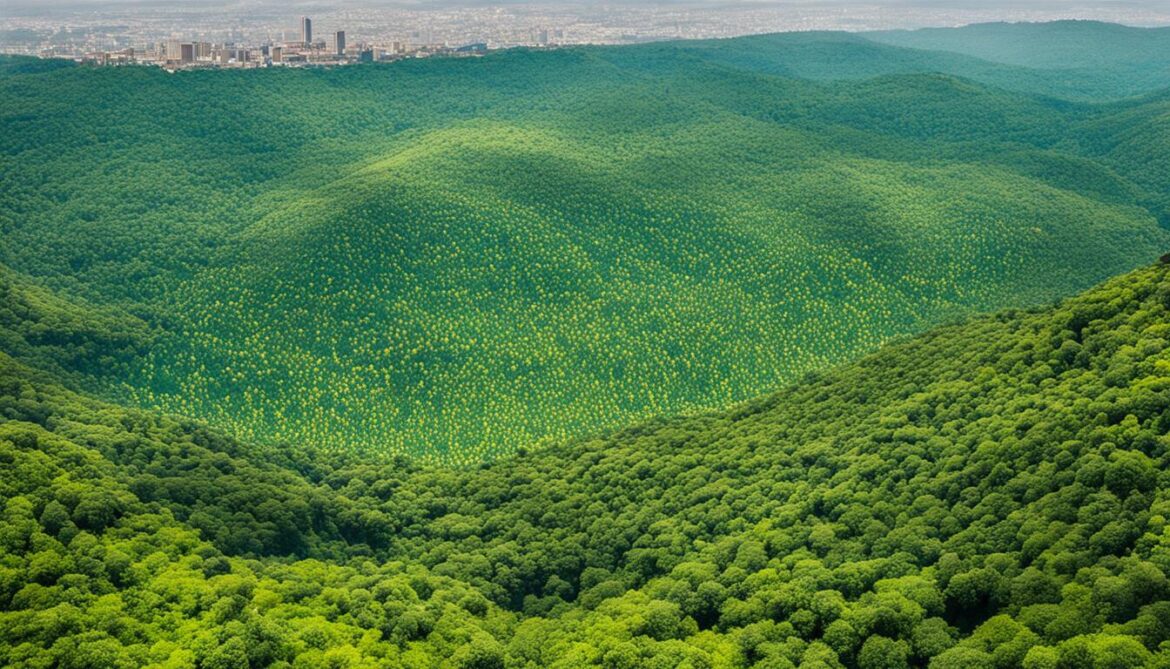
Wildlife corridors serve as vital pathways that connect fragmented habitats and enable the movement of wildlife. These corridors play a crucial role in ensuring species’ access to necessary resources, such as food, water, and mates. They also facilitate gene flow between populations, promoting genetic diversity and increasing the resilience of species in the face of environmental challenges.
By establishing wildlife corridors across Ethiopia, the country aims to improve overall habitat connectivity and mitigate the negative effects of habitat fragmentation. This proactive approach helps to safeguard the long-term survival of numerous species and contributes to the conservation of Ethiopia’s unique biodiversity.
Promoting Sustainable Wildlife Management
Sustainable wildlife management is a key component of Ethiopia’s wildlife preservation initiatives. The country strives to strike a balance between conserving wildlife and enabling sustainable use of natural resources.
Through regulations and enforcement measures, Ethiopia aims to prevent illegal poaching and trade of wildlife, which significantly threaten many species. By addressing the underlying causes of poaching, such as poverty and lack of alternative livelihoods, Ethiopia seeks to ensure the long-term survival of its wildlife populations.
Furthermore, sustainable wildlife management includes measures to address habitat loss and degradation, such as reforestation efforts and the restoration of degraded ecosystems. By actively managing and protecting wildlife habitats, Ethiopia creates a conducive environment for both wildlife conservation and sustainable human activities.
Overall, Ethiopia’s wildlife preservation initiatives reflect the country’s commitment to protect its rich biodiversity and ensure the continued existence of endangered species. Through the establishment of wildlife corridors, species conservation programs, and sustainable wildlife management practices, Ethiopia sets an example for global conservation efforts and secures a sustainable future for its remarkable wildlife.
Balancing Conservation and Development in Ethiopia
Ensuring a harmonious balance between conservation and development is a top priority in Ethiopia. While economic growth and development are crucial for improving the livelihoods of the population, it is equally important to ensure that these activities are conducted in a sustainable and biodiversity-friendly manner. This can be achieved through the implementation of robust environmental regulations, the promotion of sustainable practices in industries such as agriculture and construction, and the integration of biodiversity considerations into development projects.
The key to achieving sustainable growth in Ethiopia lies in adopting environmentally conscious approaches to development. By implementing policies and regulations that prioritize conservation and sustainable resource management, Ethiopia can reap both environmental and economic benefits. This includes utilizing biodiversity-friendly practices such as sustainable land use, responsible waste management, and the preservation of natural habitats.
Biodiversity-friendly practices in industries such as agriculture and construction not only contribute to the protection of ecosystems and wildlife but also result in numerous economic benefits. Sustainable agricultural practices, for example, can lead to increased crop yields, improved soil fertility, and reduced water and chemical inputs. Similarly, incorporating biodiversity-friendly design principles into construction projects can enhance energy efficiency, reduce waste generation, and improve the overall quality of buildings and infrastructure.
Promoting sustainable practices in industries such as agriculture and construction not only safeguards the environment but also drives economic growth by attracting investment, creating job opportunities, and enhancing the overall quality of life for citizens.
Furthermore, integrating biodiversity considerations into development projects is essential to minimize the negative impacts on natural ecosystems. This involves conducting thorough environmental assessments, identifying potential risks, and implementing mitigation strategies to ensure that development activities do not lead to habitat destruction or species loss. By promoting sustainable approaches and incorporating biodiversity-friendly practices, Ethiopia can strike a balance between conservation and economic development.
Ultimately, achieving sustainable growth in Ethiopia requires a comprehensive approach that considers both conservation and development. By actively protecting and preserving biodiversity through the implementation of sustainable practices, Ethiopia can secure long-term economic benefits while safeguarding its natural heritage and ensuring the well-being of its people.
The Benefits of Balancing Conservation and Development
When conservation and development are effectively balanced, the advantages extend beyond protecting the environment. By prioritizing sustainability, Ethiopia can unlock several benefits, including:
- Economic growth and stability
- Enhanced resilience to environmental changes
- Preservation of cultural and historical heritage
- Improved quality of life for communities
- Enhanced provision of ecosystem services
- Increased attractiveness for tourism and investment
These benefits highlight the importance of nurturing a symbiotic relationship between conservation and development in Ethiopia. By embracing sustainable practices and biodiversity-friendly initiatives, Ethiopia can achieve a prosperous future that balances economic growth, environmental stewardship, and social well-being.
| Biodiversity-Friendly Practices | Economic Benefits |
|---|---|
| Promotion of sustainable land use | Increased agricultural productivity |
| Responsible waste management | Cost savings through resource efficiency |
| Preservation of natural habitats | Enhanced ecotourism opportunities |
| Integration of green infrastructure | Improved public health and well-being |
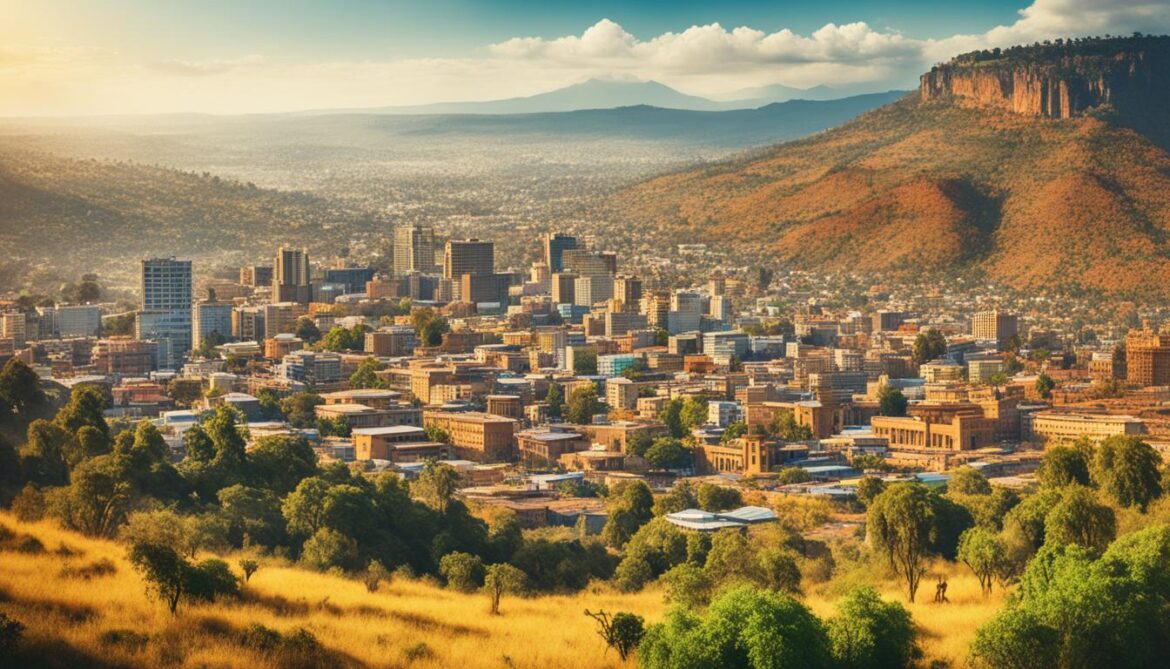
The Future of Ethiopia’s Biodiversity and the Built Environment
The future of Ethiopia’s biodiversity and the built environment depends on the continued commitment to conservation and sustainable construction practices. It is essential for all stakeholders to work together towards implementing environmental policies, conservation strategies, and green building practices.
To ensure a sustainable future, it is crucial to raise awareness about the importance of biodiversity and its role in preserving the ecological balance. By prioritizing sustainable urban planning, Ethiopia can create cities that coexist harmoniously with nature while still supporting development.
Investing in research and innovation is key to developing eco-friendly construction methods that minimize the environmental footprint. This includes exploring alternative building materials, promoting energy efficiency, and adopting sustainable waste management practices.
“The conservation of biodiversity and the promotion of sustainable construction practices go hand in hand. By preserving Ethiopia’s diverse ecosystems and embracing sustainable development, we can create a future where environmental conservation and economic growth thrive together.”
In addition to individual efforts, the government should play a significant role by implementing and enforcing environmental policies that require the integration of conservation practices in all phases of construction. By emphasizing the importance of biodiversity in policy frameworks, Ethiopia can set a strong precedent for sustainable development.
Promoting Conservation Awareness
An essential aspect of securing the future of Ethiopia’s biodiversity and the built environment is fostering a culture of conservation. This can be achieved through education and awareness campaigns that highlight the significance of preserving natural resources, protecting endangered species, and restoring ecosystems.
Listed below are some strategies that can be implemented to promote conservation awareness:
- Integrate conservation education into school curricula
- Organize community events and workshops on biodiversity preservation
- Engage local communities through conservation projects and initiatives
- Collaborate with media outlets to create informative content about biodiversity conservation
- Encourage public participation in citizen science programs and wildlife monitoring
Sustainable Construction Practices
Adopting sustainable construction practices is crucial for minimizing the environmental impact of the built environment. By integrating green building principles, Ethiopia can achieve long-term sustainability and reduce its carbon footprint.
Some key sustainable construction practices that can be implemented include:
- Using renewable and locally sourced building materials
- Incorporating energy-efficient designs and systems
- Implementing water conservation measures
- Managing construction waste through recycling and upcycling
- Promoting biodiversity-friendly landscaping and green spaces in urban areas
By embracing sustainable construction practices, Ethiopia can ensure that future development projects are in harmony with nature, preserving biodiversity while meeting the needs of a growing population.
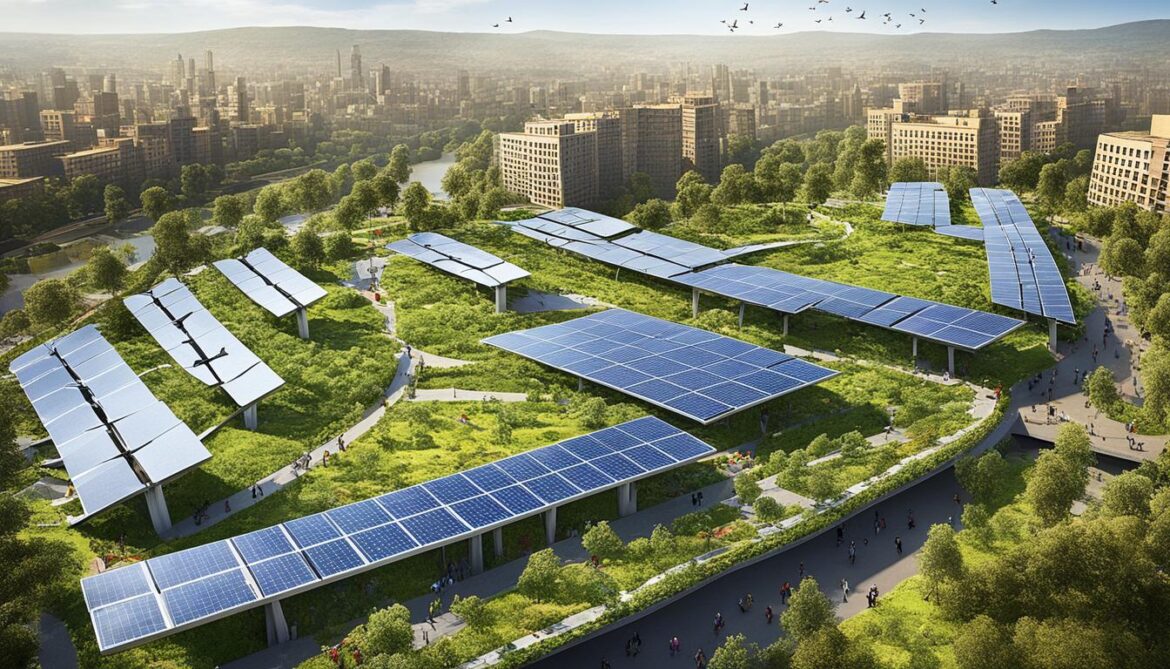
| Conservation Strategies | Environmental Policies |
|---|---|
| Promoting wildlife conservation and habitat restoration | Implementing regulations to minimize environmental impact |
| Establishing protected areas and wildlife corridors | Encouraging sustainable practices in industries |
| Fostering partnerships with local communities and organizations | Supporting research and innovation for eco-friendly technologies |
| Preventing illegal wildlife trade and poaching | Integrating conservation considerations in development plans |
Conclusion
Ethiopia’s rich biodiversity and the built environment are intricately connected, and striking a balance between conservation efforts and urban development is crucial for the country’s sustainable future. By incorporating biodiversity considerations into urban planning and promoting sustainable architecture and construction practices, Ethiopia can safeguard its diverse ecosystems, protect wildlife, and bolster economic growth while improving the well-being of its citizens.
Stakeholders in Ethiopia must continue to collaborate and prioritize biodiversity conservation, implementing environmentally-friendly practices that harmonize the built environment with the natural world. This includes integrating green building practices, minimizing the environmental impact of urban development projects, and fostering ecological diversity through sustainable design and construction approaches.
By prioritizing the Ethiopia Biodiversity and the Built Environment, the nation can create a future where sustainable architecture, conservation efforts, and green building practices coexist harmoniously. It is only through collaborative effort and commitment that Ethiopia can navigate the delicate balance between development and preservation, ensuring a sustainable and prosperous future for generations to come.
FAQ
What is biodiversity and why is it important?
Biodiversity refers to the variety of life on Earth, including genes, species, and ecosystems. It is important for maintaining ecological balance, mitigating climate change, and ensuring the resilience of ecosystems. Biodiversity provides essential benefits to society, such as ecosystem services and economic resources.
What is the current status and threats to biodiversity in Ethiopia?
Ethiopia’s biodiversity faces threats such as habitat loss and degradation, deforestation, pollution, and climate change. These factors contribute to the decline of species populations and the degradation of natural ecosystems, including vulnerable areas like afroalpine areas and montane forests.
What conservation efforts are being made in Ethiopia to protect biodiversity?
Ethiopia has established protected areas, like national parks and wildlife reserves, and promotes both in-situ and ex-situ conservation. Sustainable use of biodiversity resources is also emphasized, along with the management of forests, agriculture, and wildlife.
How does sustainable architecture contribute to the protection of biodiversity?
Sustainable architecture minimizes the environmental impact of buildings by implementing green building practices and ecosystem-friendly design principles. It focuses on reducing energy consumption, conserving water, using renewable materials, and creating healthy and environmentally-friendly spaces.
What is the environmental impact of urban development projects in Ethiopia?
Urban development projects in Ethiopia can result in habitat destruction and ecosystem fragmentation, contributing to the loss of biodiversity. The expansion of cities and the construction of new buildings often lead to the conversion of natural habitats into urbanized areas.
How can biodiversity conservation be integrated into urban planning?
Urban planners can incorporate green infrastructure, such as parks and urban forests, into urban planning to provide habitats for wildlife and contribute to biodiversity conservation. The protection of natural areas and the restoration of degraded ecosystems can also be prioritized in the development process.
What initiatives are in place to preserve wildlife in Ethiopia?
Ethiopia has established wildlife corridors to connect fragmented habitats and facilitate the movement of wildlife. It also focuses on species conservation, preventing poaching, addressing habitat loss, and promoting sustainable wildlife management.
How can conservation and development be balanced in Ethiopia?
Balancing conservation and development in Ethiopia requires the implementation of environmental regulations, sustainable practices in agriculture and construction, and the integration of biodiversity considerations into development projects. This approach aims to achieve both conservation goals and economic benefits.
What does the future hold for Ethiopia’s biodiversity and the built environment?
The future of Ethiopia’s biodiversity and the built environment depends on continued commitment to conservation and sustainable construction practices. It is important to prioritize biodiversity conservation, implement environmentally-friendly practices, and ensure a harmonious relationship between the built environment and the natural world.



